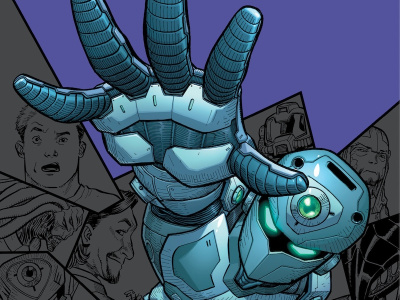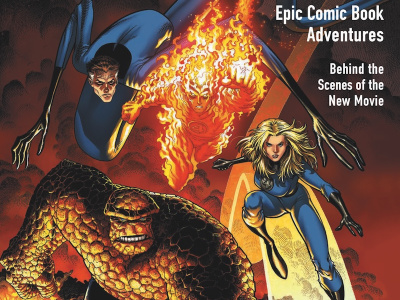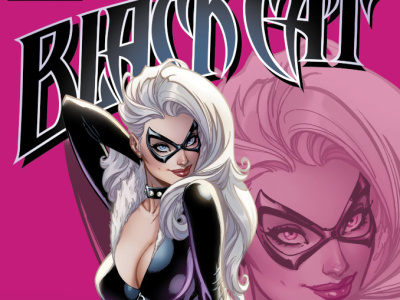
Dave Gibbons, the co-creator of Watchmen, took time to talk to ICv2 about his involvement with Madefire, which has developed a new app for digital comics that takes advantage of the capabilities of the iPad to evolve the grammar of graphic storytelling. We ask Gibbons about the future of comics (and comic stores), and get an interesting non-answer to a question about his opinion of DC Comics’ Before Watchmen. Gibbons will talk more about these topics at the ICv2 Conference on Comics & Digital II at New York Comic Con.
How did you get involved with Madefire?I’ve been a friend of Liam Sharp’s for a long, long time, and I’ve always watched with interest the various publishing ventures that he’s been involved with. Last year he talked to me about Madefire and I thought, this is exactly the kind of area I would like to be in. I asked him to tell me more and at San Diego last year--2011--I met up with him, Ben Wolstenholme and Graves Englund, the people behind Madefire. We all got on very, very well. We all seem to be on the same wavelength. We had rather a humble presence last year at San Diego--just kind of three people behind a fairly bare table, but this year we had a wall of iPads, a whole complete staff and really fantastic feedback from publishers and artists and fans.
What’s your high concept description of what Madefire is?
Wow. The term that we bandied around was that reading comics on the Madefire platform is a bit like reading comics on "intelligent" paper in that it’s got all the virtues of regular paper but it can do a whole lot of other things that a printed version can’t. There are wonderful things it can do with movement of the tablet, with animated transitions, and with ambient and event sound. We’ve also talked about creating the new grammar of graphic storytelling. The more involved I’ve become with this, the more I’ve seen that we’re not only inventing new properties and new stories, but actually whole ways of telling the story and it’s evolving even as we’re doing it. I find that very exciting.
Wow. The term that we bandied around was that reading comics on the Madefire platform is a bit like reading comics on "intelligent" paper in that it’s got all the virtues of regular paper but it can do a whole lot of other things that a printed version can’t. There are wonderful things it can do with movement of the tablet, with animated transitions, and with ambient and event sound. We’ve also talked about creating the new grammar of graphic storytelling. The more involved I’ve become with this, the more I’ve seen that we’re not only inventing new properties and new stories, but actually whole ways of telling the story and it’s evolving even as we’re doing it. I find that very exciting.
One of the differences we noticed that changes the reading experience from how you traditionally read comics is the addition of word balloons in sequence, which means you don’t have to go left to right or by position, you communicate who’s speaking at what time by when the word balloons appear. What other key differences would you say are most important in the reading experience of a Madefire Motion Book versus a traditional comic?
I think it’s still a reading experience and it’s most important to me that it is that. I was involved with the Watchmen Motion Comics, which were more like limited animation than a true reading experience, but we learned some interesting lessons from that. I think it is keeping the control with the reader, but it is also allowing the reader to control the speed of transition--to look around the real estate of the page. We’re able to do things like 360 degree panoramas, but again, by careful placement of graphic elements and text elements, you can still make it clear the direction that the reader has to take through the story.
I think it’s still a reading experience and it’s most important to me that it is that. I was involved with the Watchmen Motion Comics, which were more like limited animation than a true reading experience, but we learned some interesting lessons from that. I think it is keeping the control with the reader, but it is also allowing the reader to control the speed of transition--to look around the real estate of the page. We’re able to do things like 360 degree panoramas, but again, by careful placement of graphic elements and text elements, you can still make it clear the direction that the reader has to take through the story.
The other interesting thing about it is that it’s never fixed. With a printed comic, once the comic is printed, that is it, but with a digital comic you can always add pages, you can always elaborate on sequences. You can, if you like, go off in perpendicular or parallel directions to the main narrative. Those are few of the additions to the reading experience that I would specify.
In the Madefire app, are we downloading the content or are we reading it off the Madefire server?
You are actually downloading the content but that doesn’t prevent us from being able to update the content and offering that as just a straightforward update without further expense. At the moment we’re giving all the stories away free. Obviously as things go on that won’t always be the case, but I think the thing to do now is to involve the reader and reward loyalty. That’s the way to go.
You are actually downloading the content but that doesn’t prevent us from being able to update the content and offering that as just a straightforward update without further expense. At the moment we’re giving all the stories away free. Obviously as things go on that won’t always be the case, but I think the thing to do now is to involve the reader and reward loyalty. That’s the way to go.
There seems to be a focus on creator tools at Madefire. For the creator, what are the differences between creating something for reading as a Madefire Motion Book and creating a traditional comic?
Again that’s something we’re discovering as we actually do it. I’ve not had the opportunity to provide much original artwork for it. I’ve been able to write a couple of stories, and even writing the stories you find yourself using different language. You realize that you don’t have to number the pictures anymore. The script reads much more like a screenplay, where you transition from one picture to the next, rather than in a comic book where there’s an implied cut between each picture. Even if you are remaining within the same scene, it’s a very abrupt change, so just the simple act of writing the script evolves.
Again that’s something we’re discovering as we actually do it. I’ve not had the opportunity to provide much original artwork for it. I’ve been able to write a couple of stories, and even writing the stories you find yourself using different language. You realize that you don’t have to number the pictures anymore. The script reads much more like a screenplay, where you transition from one picture to the next, rather than in a comic book where there’s an implied cut between each picture. Even if you are remaining within the same scene, it’s a very abrupt change, so just the simple act of writing the script evolves.
With the artwork, you have to think in terms of layers--in terms of foreground, middle ground, back ground and keeping those separate so you can move elements against the background or have elongated background, for instance, that you can truck along. So, there is an additional layer of work, but as long as you’re doing it the Madefire way, you can compress the elements at the end and provide a satisfying reading experience in a traditional book.
I happen to think that people interested in comic book material are lovers of books as well and I certainly like to have a hard copy of something that I really enjoy. If you do it this way from the digital to the static you leave yourself possibilities. If you do it from the static to the moving, as we found with the Watchmen Motion Comics, there’s a lot of spade work to be done just to make that happen. The Madefire tool will be made available free so that both professional and amateur comic artists can experiment with getting their work onto the Madefire platform. They’ll be able to create material and preview it on their iPad or other tablet devices in the future. And, we think it’s really important to try to create a community of artists, writers and creators, much in the same way as deviantART has brought together a lot of people who are interested in science fiction or fantasy illustration. I think it’s a very mutually enriching experience that we can all learn from each other and kind of move what is at the moment a sort of infant, hybrid art form forward.
Sounds like you’re seeing the possibility of creating print versions of the material created for Madefire, is that right?
That’s correct. That’s always been part of the plan.
That’s correct. That’s always been part of the plan.
What are your thoughts about the role of the comic shops, which have been so important in nurturing the audience for comics over the past few decades, in the coming years as more content is created for digital platforms?
I do understand this concern and it’s a little bit of a dilemma. I love comic shops as much as the next fan. I’m very good friends with the guy who runs my local comic shop, and I realize what a social hub it is for local comic fans. So I would really hate to see comics stores go under, and I’d really hate to feel that I was doing anything to make them go under.
I do understand this concern and it’s a little bit of a dilemma. I love comic shops as much as the next fan. I’m very good friends with the guy who runs my local comic shop, and I realize what a social hub it is for local comic fans. So I would really hate to see comics stores go under, and I’d really hate to feel that I was doing anything to make them go under.
As with other forms of entertainment--music, video and the ability to download information (and in this case it’s entertainment information), the digital revolution is kind of unstoppable. I think we have to accept the reality that it is a much quicker, more convenient, and possibly cheaper way for people to get entertainment.
Having said that, I do think comic shops as they are today, because they do cater to people who really are fans and not to the general public, will still be able to sell collectible things to collectors. Perhaps the format of a monthly comic being collected into a trade paperback will not be the norm, it might be that you have a monthly download and that’s then collected into a trade paperback.
A lot of comic stores nowadays are diversifying into games and other collectibles, and I think it is inevitable that they will have to do that. I think it would be fair to say that some comic stores will have to improve their levels of service. My particular comic store and other comics stores I go into are very well run and very customer friendly, but I think it’s incumbent on the retailer to do everything he or she can to make going into a comic shop a pleasant experience. And I think by a nice environment, by being nice and friendly, and being inclusive rather than exclusive, the community around the shop will be nurtured and hopefully that will enable the better comic shops to continue.
You talked about the Watchmen Motion Comics being closer to limited animation. T he use of in-panel motion and sound for some people moves it in the direction of animation and away from comics. Where do you think the line is between comics and animation?
This is all evolving literally as we speak, so this is my provisional take on it. I do think the crucial difference is between being a reader and being spectator--with something like the Watchmen Motion Comic you were very much a spectator watching the equivalent of an animated film or a regular movie. But with the Madefire app, you are definitely a reader. That is reinforced if you limit animation and movement to that of the camera. In other words, if you make use of pans and zooms and use depth of field and effects like that (which seem like the extension of the reader as camera man rather than trying to make elements within the pictures move), that can work, but it doesn’t always work. And of course the most difficult thing to replicate in animation, whether it’s limited Saturday morning style animation or full blown cinema screen CG effects, is to make human beings move convincingly. I think we’ve definitely found the one thing that we’re going to steer very clear of is any attempt to animate living objects.
This is all evolving literally as we speak, so this is my provisional take on it. I do think the crucial difference is between being a reader and being spectator--with something like the Watchmen Motion Comic you were very much a spectator watching the equivalent of an animated film or a regular movie. But with the Madefire app, you are definitely a reader. That is reinforced if you limit animation and movement to that of the camera. In other words, if you make use of pans and zooms and use depth of field and effects like that (which seem like the extension of the reader as camera man rather than trying to make elements within the pictures move), that can work, but it doesn’t always work. And of course the most difficult thing to replicate in animation, whether it’s limited Saturday morning style animation or full blown cinema screen CG effects, is to make human beings move convincingly. I think we’ve definitely found the one thing that we’re going to steer very clear of is any attempt to animate living objects.
The term "Motion Books" implies there will be other content besides comics. Is that true?
Well as the content evolves, it may move further away from what you would traditionally think of as comics. One thing I’ve been struck by is the move away from what you or I, with our long time experience in the field, might term "comics," which is essentially drawings with a black line around them to hold color. That really is a legacy of a fairly primitive printing process. There’s no need to have a black line around objects; in fact I think some of the most successful things on the digital scene don’t use that traditional view of comics. There will always be a place for it because it’s an abstraction that seems to work well, but I think we’ll be able to deconstruct what there is on a comic page and put it back together in a different way, but with the same innate advantages of traditional comics.
Well as the content evolves, it may move further away from what you would traditionally think of as comics. One thing I’ve been struck by is the move away from what you or I, with our long time experience in the field, might term "comics," which is essentially drawings with a black line around them to hold color. That really is a legacy of a fairly primitive printing process. There’s no need to have a black line around objects; in fact I think some of the most successful things on the digital scene don’t use that traditional view of comics. There will always be a place for it because it’s an abstraction that seems to work well, but I think we’ll be able to deconstruct what there is on a comic page and put it back together in a different way, but with the same innate advantages of traditional comics.
Something I’ve always found attractive about comics, and it does hold for the Madefire approach as well, is that unlike motion pictures or high budget animation, the creator is able to get his or her vision very directly to the reader. In all the work I’ve done in comics, what the reader is seeing is essentially exactly what I put down without any mediation or compromise with producers, directors or other people. I think that’s going to continue to be the most attractive thing with what we’re doing with Madefire in that a creator will be able to transmit their ideas very directly to the ultimate consumer.
You mentioned you were doing some writing for the Madefire platform. Are there any stories by you on the platform now?
The stories by me at the moment are kind of an origin story (or perhaps more of an orientation story), which I wrote that serves as a lead in to the globally scattered Treatment stories. There’s also a very short and somewhat whimsical and satirical piece that I did for our launch at San Diego this year. The whole Treatment thing is based on an idea I’ve been kicking around for a long time and first actualized for a short story in Dark Horse Presents, which is an anthology title. I had a short, 12-page fragment there that I both wrote and drew. When we came to discuss Madefire, it became apparent that a lot of the ideas that I encapsulated in that story would be ideal for Madefire.
The stories by me at the moment are kind of an origin story (or perhaps more of an orientation story), which I wrote that serves as a lead in to the globally scattered Treatment stories. There’s also a very short and somewhat whimsical and satirical piece that I did for our launch at San Diego this year. The whole Treatment thing is based on an idea I’ve been kicking around for a long time and first actualized for a short story in Dark Horse Presents, which is an anthology title. I had a short, 12-page fragment there that I both wrote and drew. When we came to discuss Madefire, it became apparent that a lot of the ideas that I encapsulated in that story would be ideal for Madefire.
I do have a longer movie-length story that I would like to get to as soon as time permits, which hopefully will be toward the end of this year. That’s something that we plan to serialize on Madefire, and then ultimately with a view to collecting it into a larger Madefire experience, certainly a print graphic novel, and who knows, maybe games and movies beyond that.
Is that a Treatment story, or something else?
It’s a Treatment story. It was the story idea I had when I first conceived Treatment and at the moment only a small fragment has appeared, but it’s independent of any of the Treatment stories that have appeared by other creators in the meantime.
It’s a Treatment story. It was the story idea I had when I first conceived Treatment and at the moment only a small fragment has appeared, but it’s independent of any of the Treatment stories that have appeared by other creators in the meantime.
There’s not visible business model yet for Madefire. What’s the plan for the business model for the company?
I’m probably not the best guy to speak to about the business model. I’m essentially a writer and artist and when we’ve been doing presentations on this I tend to leave questions about a business model to Ben Wolstenholme or Graves who have a much clearer idea about this and could probably talk about this more coherently than me.
I’m probably not the best guy to speak to about the business model. I’m essentially a writer and artist and when we’ve been doing presentations on this I tend to leave questions about a business model to Ben Wolstenholme or Graves who have a much clearer idea about this and could probably talk about this more coherently than me.
Anything else you wanted to talk about as far as Madefire?
At the moment, it’s a free app and we’re giving the stories away free. I think now is a perfect time for people to taste it and see if it’s to their liking. What’s apparent is this whole area of digital comics or interactive comics or tablet comics, or whatever you want to call it--is a bit like the Wild West. There’s a lot of people spurring their horses onward toward "them thar hills" and we all know that there’s gold out there somewhere, but not quite who’s going to make the lucky claim, I don’t know. Certainly Madefire is very well funded and has wonderful people associated with it and I’d like to think that we’re going to be leading players in the land grab, but it’s really interesting to see the thing evolve and be a part of it.
At the moment, it’s a free app and we’re giving the stories away free. I think now is a perfect time for people to taste it and see if it’s to their liking. What’s apparent is this whole area of digital comics or interactive comics or tablet comics, or whatever you want to call it--is a bit like the Wild West. There’s a lot of people spurring their horses onward toward "them thar hills" and we all know that there’s gold out there somewhere, but not quite who’s going to make the lucky claim, I don’t know. Certainly Madefire is very well funded and has wonderful people associated with it and I’d like to think that we’re going to be leading players in the land grab, but it’s really interesting to see the thing evolve and be a part of it.
For all the many years I’ve been in the business, I’ve always been interested in what’s around the next corner or what the next thing’s going to be. I’ve been using computers for the last 20 years and I’m as much of a gadget freak as I am a comics geek, so yes, it’s a really interesting field to be involved in for me.
What are you working on for print right now?
I’m currently getting to the end of series I’ve been doing with Mark Miller called The Secret Service. It’s an espionage story with a little bit of a twist, and we’re doing that through Marvel Icon. That’s keeping me pretty busy at the moment, and I’ve been doing quite a bit of promotion and traveling this year.
I’m currently getting to the end of series I’ve been doing with Mark Miller called The Secret Service. It’s an espionage story with a little bit of a twist, and we’re doing that through Marvel Icon. That’s keeping me pretty busy at the moment, and I’ve been doing quite a bit of promotion and traveling this year.
I’m looking forward to doing much more with Madefire. I also want to do a little bit more writing. I have a few personal ideas that I want to investigate. I think I’ve reached a point where perhaps an autobiography of a sort might be interesting and I’m looking forward to having some time to sit down and put together my thoughts on that.
We’ve seen comments you made when DC announced the Before Watchmen titles. As co-creator of the original work, do you have any comments on what you’ve seen so far on Before Watchmen line?
Well I did give DC a very carefully crafted quote and really haven’t got anything to add to that. Really, it’s the kind of situation where I either say nothing or I say everything, so my stance at the moment is to say nothing. That’s not to say that will always be my stance, but it is now.
--Interview by Milton Griepp
Well I did give DC a very carefully crafted quote and really haven’t got anything to add to that. Really, it’s the kind of situation where I either say nothing or I say everything, so my stance at the moment is to say nothing. That’s not to say that will always be my stance, but it is now.
--Interview by Milton Griepp







